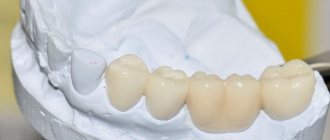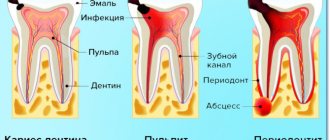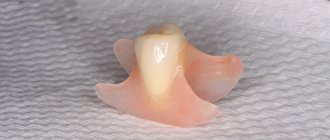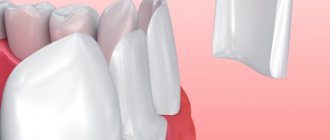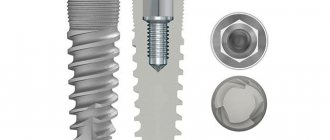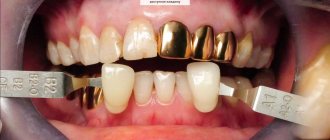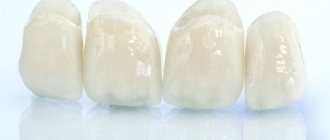Modern dental technologies make it possible to save a tooth even if it is severely damaged. For advanced caries and the complications that often accompany it, treatment is carried out in stages. First, medicine is placed into the canals, and only after some time the tooth is filled permanently. This explains why a temporary filling is placed. Depending on the clinical picture, the period of its use may vary.
Temporary filling: what is it and what is it for?
If urgent treatment is not possible, temporary filling material is placed. It does not have sufficient strength, so it is not suitable for permanent filling. But it allows you to close the tooth cavity for a certain period.
A temporary filling is placed in the treatment of pulpitis and periodontitis after cleaning the canal. It is also needed for diagnostics, when it is necessary to determine the nature of the inflammatory process and check how deep the damage is. Why is such material used for prosthetics and indirect restoration? It will protect the prepared tooth until the permanent structures are ready.
This is an excellent technique when you need to delay treatment. It also acts as a kind of insurance for the doctor, as it allows you to monitor the effect of treatment and prevent the occurrence of complications. Why do they put a temporary filling after the medicine? It will prevent the drug from seeping into the oral cavity. This method is used when devitalizing paste is applied or root canals are filled with medicinal pastes. After some time, you can clean the canal and fill the tooth.
Probably many people have had to deal with temporary fillings more than once. Treatment of caries, pulpitis, periodontitis, as well as prosthetics is rarely complete without the use of a filling procedure. Using a filling, the structure of the dental tissue is restored, as well as the appearance and all functions of the tooth. However, usually during treatment, many dentists use two types of fillings - temporary and permanent . While permanent is usually used for long-term bone replacement, temporary is used only for short-term cavity protection. It usually contains inexpensive materials that can be easily cleaned later.
Why do they put a temporary filling?
Why a temporary filling and why can’t you immediately put a permanent one? This is a special design that is placed during the treatment of deep caries, pulpitis, as well as inflammatory processes in the root canals. It serves as a kind of barrier that prevents the medical pad from falling out or bacteria from entering the open cavity after cleaning the canals.
The main indications for installing a temporary filling are:
- the need for a diagnostic examination;
- treatment of caries that has resulted in serious destruction of dental tissues, or pulpitis;
- for thorough cleaning of the carious cavity (in especially rare cases);
- for the purpose of manufacturing a stump inlay and installing a permanent filling in the future;
- if urgent treatment is impossible for some reason and it is necessary to postpone the procedure for some time.
Temporary and permanent fillings - what's the difference?
The main difference lies in the name itself - a temporary filling is installed for a short limited period of time, while the service life of a permanent filling is on average 5 years. They also differ in materials. If for a permanent structure they resort to reliable compounds that, after hardening, become durable and wear-resistant, then in the case of temporary solutions it all depends on the specific situation. This may be a filling with a drug, arsenic to kill the pulp, or from a material that hardens quickly, but is not particularly strong.
It should be understood that a temporary filling is not a way to save money, but a forced necessity. In what cases it is installed, we have already found out. It is logical that permanent fillings are an order of magnitude more expensive than their temporary counterparts, and the point here is in specific tasks - restoring the aesthetics and functional component of the tooth. The choice of a certain type of temporary filling is made by the doctor, based on the existing clinical picture. The material of the permanent filling can be chosen by the patient himself, taking into account his problem and financial situation.
Types of temporary filling depending on the material
The material used to install a temporary filling is non-toxic, environmentally friendly and does not pose any danger to the body. At the same time, it is quite plastic, can occupy any volume, and has the property of rapid drying.
Depending on the practical application, a temporary filling may contain different compositions, in particular:
- Artificial dentin. It is the most common substance for making temporary fillings. It contains zinc oxide and kaolin. For quick hardening (up to 3 minutes) mix with a small amount of water.
- Dentin pastes. Slightly increased hardening time of the substance due to the fact that essential oils are used instead of water (as in the case of artificial dentin).
- If there is a need for temporary filling of dental canals, a mixture of Karyosan is used.
- to relieve pain and relieve inflammation.
How long can you walk with a temporary filling?
From the name itself it follows that such a design has a limited wearing period. So, if you spend too much time wearing such a filling, it will not only be of no benefit, but can even cause harm. So how long is it usually set? In fact, it all depends on the type and purpose. For example, in order to kill the pulp, such a structure is fixed for 1-2 weeks. As for temporary filling before prosthetics, you will have to wait until the permanent product is ready. But again, no more than a month.
Important rules to remember when installing a temporary filling
Whatever the problem with the tooth, it is worth remembering that a temporary filling is not the solution. It only temporarily replaces permanent filling. The doctor uses it only to identify the main cause that caused pain, caries and other pathological disorders. Therefore, you should not use this material for long-term use. Sooner or later it will collapse and the cavity will open again. Needless to say, what harmful substances can get there along with food and saliva? As a result, you can completely lose a healthy tooth. Therefore, you must strictly adhere to the important recommendations of your doctor.
In addition, after installation, you should follow several important oral care tips:
1.After installation, do not forget about thoroughly brushing your teeth and rinsing your mouth;
2.Since fairly hard materials are used for temporary fillings, regular toothbrushes can be used for cleaning. Their bristles will not harm the material;
3.The main thing when cleaning is not to be too zealous, it is better to do everything neatly and carefully;
4.Don't overeat too solid foods. Nuts, crackers, and bones can cause serious harm to the temporary filling, so it is better to avoid eating this food during the period of its installation.
All modern materials used for the manufacture of temporary fillings have antiseptic properties, that is, they disinfect the treated cavity in the tooth. The choice of a specific material for creating a non-permanent structure is made by the doctor based on the clinical situation he had to face.
Types of temporary fillings
Such fillings are made from environmentally friendly materials and therefore do not have a toxic effect on the body. They are flexible, easy to install, and harden quickly. Apply evenly. The following types of temporary fillings are often used in dentistry:
- Artificial dentin. The drug consists of zinc oxide, kaolin, dehydrated zinc sulfate. The substance is paste-like, which is achieved by adding water. It hardens in just 3 minutes. Often used to determine the shade of a permanent restoration - before a crown
. - Dentin pastes. The composition
of the product is the same as the previous drug. The difference is that it is mixed with essential oils. The hardening time is longer, but its strength is also better. - Karyosan. Used for filling canals.
- Zinc-evengel cement. Suitable for cases where the dental nerve is inflamed. Used as a local anesthetic.
- Polycarboxylate cement has been used in dentistry for a long time. This material hardens quickly.
- Vinoxol. Used when long-term treatment is expected.
Such compositions differ from materials that are used for permanent fillings. In the future, they must be changed.
How long does a temporary filling last and how is it removed?
The estimated service life of a temporary filling is 3-7 days (in rare cases, when using Vinoxol - 4-6 months). As practice shows, it can last on its own for 2 weeks or even a month, but such periods can have a detrimental effect on the effectiveness of treatment of a dental problem and even harm the teeth, so doctors independently remove the filling at the appointed time.
Removal is carried out by a doctor in a dental office; the removal technique directly depends on the type of material installed. For example, artificial dentin has a fairly low density - this allows removal using a medical spatula and curettes. To remove fillings made of high-strength materials, a drill can be used.
Note! In the first hours after the installation of a temporary filling, painful sensations may occur - this is due to injury to the dental and gum tissues during manipulation. If the pain does not go away within 24 hours, consult a doctor!
Filling using temporary materials
More often, such compositions are used after therapeutic and endodontic treatment. In most cases, they are preceded by x-ray diagnostics, which makes it possible to determine the type of damage and the extent of inflammation. Local anesthesia allows you to prepare, clean the carious cavity, remove the pulp and clean the canals without pain. To install a temporary filling, perform the following steps:
- treat the oral cavity with antiseptic agents;
- lay a medical pad - when required by the treatment protocol;
- filling material is placed on the tooth.
In acute periodontal disease, all actions are performed 2–3 times, so temporary compounds are used to fill the canals repeatedly. It's easy to remove them. To do this, the dentist will need a drill and hand tools.
Functions
Dentin performs such tasks as protective, trophic, sensory. The first function is to create a protective layer of the pulp and prevent pathogens from penetrating into the deeper layers. With the development of infectious processes, the pulp begins to secrete a special replacement dentin, creating an additional shell.
The second function is trophic, that is, dentin provides the necessary permeability. The layer of material is penetrated by tubules that conduct dental cerebrospinal fluid between the enamel and the layers located below. In addition, such tubules provide nutrition and innervation to tissues.
Dentin is extremely susceptible to any influence, including pain. With the development of inflammatory and other processes, pain appears, which signals a developing problem. This sensitivity protects the tooth from serious damage.
Wearing period
By determining how long a temporary filling material is placed, we can talk about its service life and the maximum possible wear without damage to the teeth. In each case, the doctor selects the most suitable composition, which has its own strength. In addition to the properties of the material, the quality of hygiene affects the service life. But if you are interested in how long it takes to walk with such a filling, you can focus on the following data:
- 1–7 days - for pulpitis, advanced caries;
- 1–3 weeks - when eliminating inflammation in the root canals;
- up to 3 months - when you need to treat a cyst, granuloma.
Based on the clinical picture and the manipulations performed, the doctor will determine the exact period of the temporary filling.
Composition and structure
A tooth is a complex system that includes the following layers:
- enamel in the form of a hard, transparent and thin tissue covering the outside of the unit;
- dentin, which has less density but greater functionality;
- cement in the form of bone tissue covering the neck and root;
- loose, soft pulp filling the cavity and conditions of blood vessels and nerve bundles.
The second layer, dentin, is an intercellular decalcified substance penetrated by tubules with processes of odontoblasts. It consists of 70-75% minerals, 20-25% organic matter (this is collagen type “1”). Water accounts for no more than 10-15%. The space of the layer is formed by collagen fibers, which are closely associated with hydroxyapatite crystals that make up the grains and granules.
Chemical composition:
- organic matter (polysaccharides, fats, proteins) and water – up to 28-30%;
- minerals (calcium fluoride, carbonate, phosphates) - about 70-72%.
Proteins are characterized by a composition that is observed in collagens. These are proline, glycine, hydroxyproline. There are no sulfur-containing acids in the composition.
What to do if a filling falls out
If the filling material falls out earlier, you should contact your doctor. In this case, there are two options for his action: either he will install a permanent filling, or he will again install a temporary one. Before visiting the doctor, you need to rinse your mouth with soda solution, mouthwash, and carefully follow the rules of hygiene.
The main thing is not to walk around with open channels, because why do they do it?
temporary fillings then? A depressurized carious cavity threatens the development of inflammation and complications.
What to do if a temporary filling falls out or begins to crumble
Given the rather low strength of the materials of temporary fillings, cases of crumbling or falling out of the filling are sometimes observed. This may be due to several factors at once: poor quality/incorrect installation, mechanical injuries or non-compliance with the dentist’s recommendations, including: consumption of rough food.
If your temporary filling falls out, don’t panic! This is certainly an unpleasant, but not a critical moment, which can be corrected by an unscheduled trip to the dental clinic. The doctor will clean the tooth from the remnants of the old filling, re-treat the tooth cavity and install a new temporary filling to continue treatment.
If you or your loved one have dental problems, contact the specialists of the AlfaDent dental clinic in Orenburg and receive qualified help from experienced doctors!
Rules of care
Compliance with the hygienist’s recommendations for temporary filling is one of the main conditions for effective therapy. You should brush your teeth twice a day and rinse them after eating. It is worth using a soft toothbrush. The use of whitening or abrasive toothpastes is not recommended.
Before permanent filling or restoration, it is better to avoid nuts, crackers, toffees and other products that place increased stress on such compounds. For several days after the filling is placed, it is better not to use coloring products, as they can change the color of the material. It is important to follow your doctor's recommendations. For example, during an inflammatory process, he may prescribe rinsing with antibacterial drugs.
Types, location areas
From an anatomical point of view, the mantle and peripulpar layers of dentin are distinguished. The first is located immediately under the enamel, the second - above the pulp. Histologically, dance and radial layers are distinguished, the differences of which relate to the location of collagen fibers.
The following types of fabrics are distinguished:
- primary, beginning to develop before the unit erupts;
- secondary, the development of which begins after the tooth has erupted;
- tertiary, also called reparative, irregular or replacement, appearing as a response to injuries and other damage.
The predentin zone is also distinguished, where secondary and tertiary species begin to form. This region belongs to the germinal region, where the process of formation of new layers begins.
Diseases
Dentin, like other tissues, is subject to age-related changes. The volume of minerals decreases, and degenerative processes begin. The tubules become narrower, sclerosis occurs, and the trophic function practically stops. Metabolic and other processes slow down, which negatively affects the strength and condition of tissues. Resistance to the development of caries decreases, teeth become thinned by various negative factors.
Caries is the main disease diagnosed most often. This is due to various nuances, for example, a local decrease in acidity, demineralization, an increase in the value of carbohydrates and others. With the death of odontoblasts and narrowing of the tubules, tissue nutrition deteriorates, which also makes the layer vulnerable to pathogenic bacteria.
Recovery methods
For treatment, it is recommended to remove the affected tissues followed by filling. After cleaning, the cavity is treated with antiseptics, which protects it from further problems. Composite fillings restore the shape and size of the tooth and allow for proper load distribution. The color is selected in accordance with the shade of the surrounding fabrics.
To prevent the development of diseases, it is recommended to regularly visit the dentist. During a routine examination, problems will be identified in a timely manner, which will allow treatment to begin while preserving tissue.
How does the installation work?
Since the composition is intermediate and is laid down for a specific purpose, it is logical that its use is preceded by certain preparatory manipulations:
- The doctor cleans the affected area using a drill and medical instruments. He carefully removes the remnants of altered tissue to prevent further destruction of the crown.
- Then it processes the channels. There are two options here - either the nerve is removed immediately, followed by washing the roots with an antiseptic, or a medicinal mixture is applied.
- A filling is placed on top, which will soon be replaced.
- Before letting the patient go, the dentist tells you how to care for the tooth , when to come next time, and what to do if the mixture falls out prematurely.
Expert opinion
Lyubov Ivanovna Kopylova
dentist-therapist
Experience: more than 10 years
Temporary filling at home is an option for those who cannot get to the doctor for quality caries treatment. This is not an alternative method of dental treatment and is not an option for those who want to save money on visiting a doctor. Caries can be cured only in a dental clinic, using modern equipment for removing pathological tissue and high-quality filling material. It is important to understand that the temporary filling that you put on yourself does not stop the destructive process!
How does the replacement work?
When the medicine under the protective “barrier” stops working, a permanent filling is installed. Using a drill, the doctor removes the remaining temporary material. Then it carries out antiseptic treatment of the opened tissues. Makes sure there are no complications and then places the permanent material.
All manipulations are carried out in one visit to the doctor. They are usually comfortable and do not require the use of painkillers - after all, the inflammation has already been cured and the nerve has been removed.
